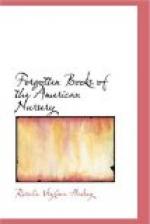The reading of one who was a boy in the older era of the urbane Addison and the witty Pope, and a man in the newer period of the novelists, is well described in Benjamin Franklin’s autobiography. “All the little money,” wrote that book-lover, “that came into my hands was laid out in books. Pleased with the Pilgrim’s Progress, my collection was of John Bunyan’s works in separate volumes. I afterwards sold them to buy R. Burton’s Historical Collections; they were Chapmen’s books, and cheap, 40 or 50 in all.”
Burton’s “Historical Collections” contained history, travels, adventures, fiction, natural history, and biography. So great was the favor in which they were held in the eighteenth century that the compiler, Nathaniel Crouch, almost lost his identity in his pseudonym, and like the late Mr. Clemens, was better known by his nom-de-plume than by his family name. According to Dunton, he “melted down the best of the English histories into twelve-penny books, which are filled with wonders, rarities and curiosities.” Although characterized by Dr. Johnson as “very proper to allure backward readers,” the contents of many of the various books afforded the knowledge and entertainment eagerly grasped by Franklin and other future makers of the American nation. The scarcity of historical works concerning the colonies made Burton’s account of the “English Empire in America” at once a mine of interest to wide-awake boys of the day. Number VIII, entitled “Winter Evenings’ Entertainment,” was long a source of amusement with its stories and riddles, and its title was handed down to other books of a similar nature. To children, however, the best-known volume of the series was Burton’s illustrated versification of Bible stories called “The Youth’s Divine Pastime.” But the subjects chosen by Burton were such as belonged to a very plain-spoken age; and as the versifier was no euphuist in his relation of facts, the result was a remarkable “Pastime for Youth.” The literature read by English children was, of course, the same; the little ones of both countries ate of the same tree of knowledge of facts, often either silly or revolting.
To deliver the younger and future generations from such unpalatable and indigestible mental food, there was soon to appear in London a man, John Newbery by name, who, already a printer, publisher, and vendor of patent medicines, seized the opportunity to issue stories written especially for the amusement of little children.
While Newbery was making his plans to provide pleasure for young folks in England, in the colonies the idea of a child’s need of recreation through books was slowly gaining ground. It is well to note the manner in which the little colonists were prepared to receive Newbery’s books as recreative features crept gradually into the very few publications of which there is record.
In seventeen hundred and forty-five native talent was still entirely confined to writing for little people lugubrious sermons or discourses delivered on Sunday and “Catechize days,” and afterwards printed for larger circulation. The reprints from English publications were such exotics as, “A Poesie out of Mr. Dod’s Garden,” an alluring title, which did not in the least deceive the small colonials as to the religious nature of its contents.




